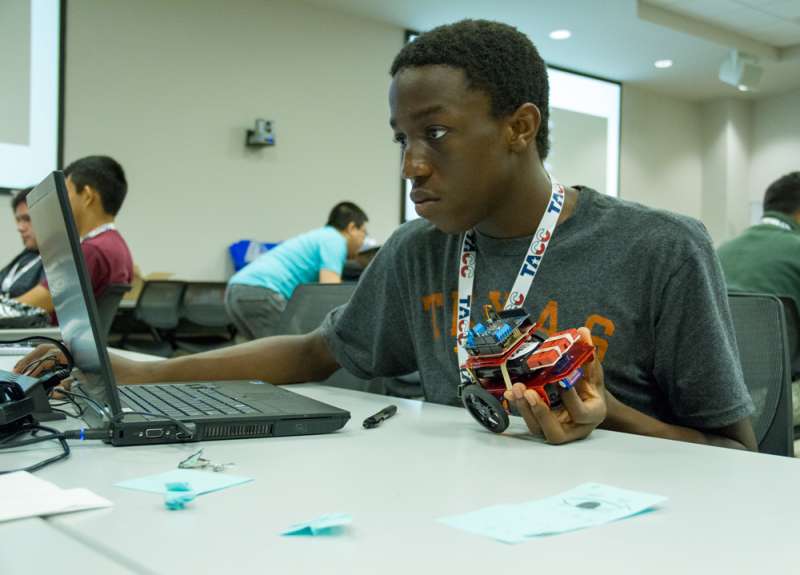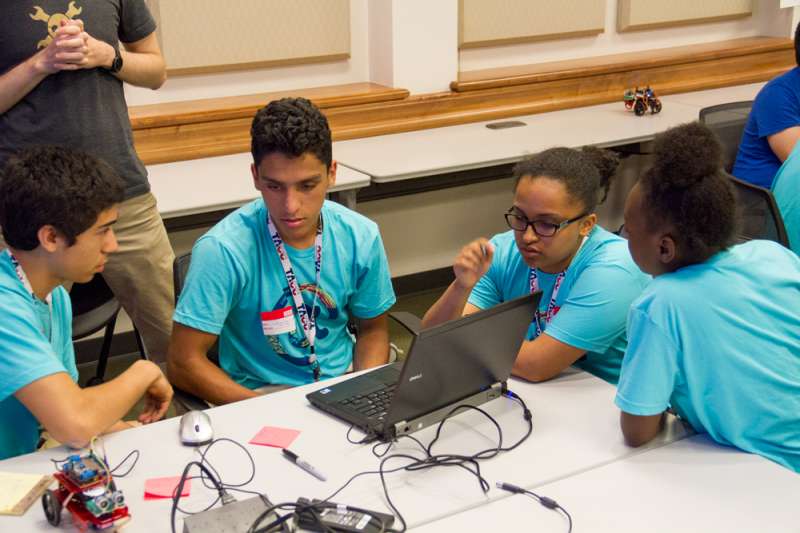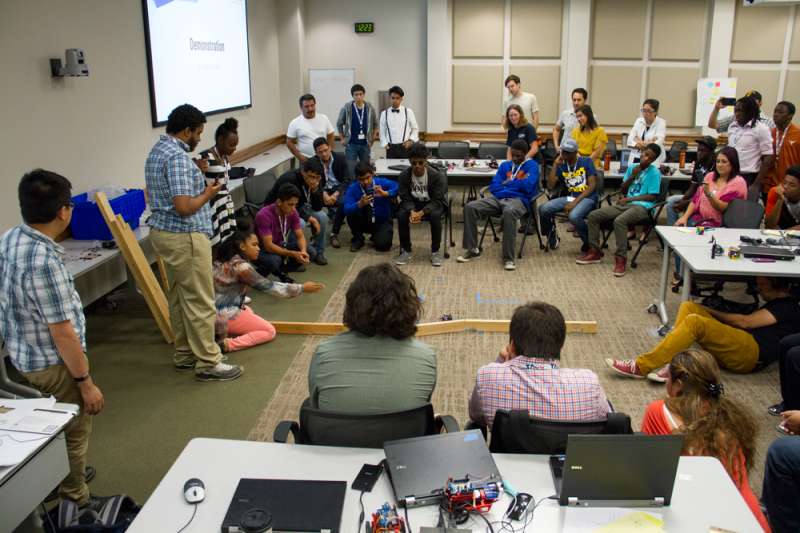Code @ TACC robotics camp delivers on self-driving cars

On a hot and breezy June day in Austin, parents, friends, brothers and sisters navigated through main campus at The University of Texas at Austin and helped carry luggage for the new arrivals to their dorm rooms. Thirty-four high school students from mostly low-income Title I schools in Central Texas, some from as far away as Houston, said good-bye to their families.
The students came for a different kind of summer camp, where for one week they became part of a science team that used computer programming and internet-connected technologies to solve a real-world problem. They had high hopes to walk away with experiences that would help them become future scientists and engineers.
From June 11 to 16, 2017, the Texas Advanced Computing Center (TACC) hosted Code @TACC Robotics, a week-long summer camp funded by the Summer STEM Funders Organization under the supervision of the KDK Harmon Foundation. The 34 students received instruction from five staff scientists at TACC and two guest high school teachers from Dallas and Del Valle, as well as round-the-clock supervision from five undergraduate proctors. Leading the camp was Joonyee Chuah, Outreach Coordinator at the TACC.
"The goal of the camp is to provide these students with their first experiences with programming, to jumpstart them and get them further ahead to things that are current in the computing world," Chuah said.
The students divided themselves into teams, each with specific roles of principal investigator, validation engineer, software developer, and roboticist. They assembled a robotic car from a kit and learned how to program the software that controls it. The robotic cars had sensors that measured the distance to objects in front, and they could be programmed to respond to that information by stopping or turning or even relaying that information to another car near it. Teams were assigned a final project based on a real-world problem, such as what action to take when cars arrive together at a four-way stop.

The Code @TACC Robotics camp went a step further than the typical introductory Lego-based robotics program by using maker-based electronics that connected to the cloud using the Particle platform. The robots assembled for the camp were three-wheeled cars that communicated via the internet and could relay events and interact with services such as Gmail, Twitter, and Facebook.
"The platform allows these robots to do a lot of communication with each other that facilitates projects that you wouldn't normally be able to do in a standard high school classroom using off-the-shelf toy robotics," Chuah said. The robotic cars presented a simplified version of the cutting-edge autonomous vehicles being developed today by leading companies such as Google.
Industry outreach was an important part of the camp, and the students toured the offices of IBM in Austin, where they participated in student activities that explored the IBM Watson supercomputer and robotics connected to it. The students also visited engineering departments and computer science departments at UT Austin, as well as TACC's world-renowned Visualization Laboratory. "They get a full experience of both college as well as future industry," Chuah said. "It's important for students to understand that there are economic and intellectual opportunities out there."
High school teachers sometimes lack the training needed to teach the more difficult programming languages like C++. Code @ TACC Robotics developed curricula and training for two guest high school teachers. "These individuals are working with us because they're excited to learn about robotics and they want to get jumpstarted on learning how to teach coding and robotics themselves," Chuah said.

Lashonda Petty of DeSoto High School and Katrina Van Houten of Del Valle High School were the guest teachers at Code @ TACC Robotics. "The camp has been really good for a lot of them. I've been talking to the students, and most of them are not pre-AP (Advanced Placement). They're not the type of kids who end up taking the harder courses, the higher sciences in their school. But they are way above in their ability to do it. They have all done amazingly well," Van Houten said.
Communicating the results of their research formed an important part of the Code @ TACC Robotics experience. They delivered their final presentations to an audience made up of TACC staff and the students' families, with translations provided in Spanish.
Central Texas student Guadalupe Oca, the software engineer for one team, explained their problem of the vehicle-to-vehicle communication at stop lights. Like the other teams, they arrived at a solution by breaking the problem down into small, and codable, bites.
"Our code was designed to make the robots stop at the stop sign. And they would decide who would be going first, just like in the real world. Humans expect the first person to go. There are those crazy drivers that just go whenever (audience laughs). They don't wait for the other person. Our initial solution was that whenever the robots get to the stop sign, they would tell each other, "I got here at nine seconds." Then the second robot gets here, and he says, "I got here two seconds after you. Go ahead and go first," said Oca.
The crowd gathered around the improvised four-way intersection marked by blue tape in the middle of the classroom. The student team looked intently into their laptops, and with a few keystrokes two robot cars whirred to life and advanced toward the intersection. One stopped at the intersection, then the other. Like a model driver, the last one to get there yielded to the first one, which then crossed the intersection safely followed by the second. The crowd cheered. If only the real-world could always behave so perfectly.
Funding for Code @ TACC Robotics camp was provided by the Summer STEM Investment Hub pooled funding comprised of the following organizations: Andy Roddick Foundation, Austin Community Foundation, KDK-Harman Foundation, and Webber Family Foundation.
Provided by Texas Advanced Computing Center





















